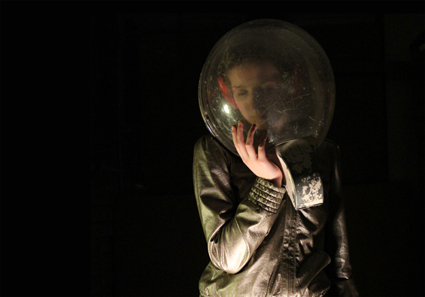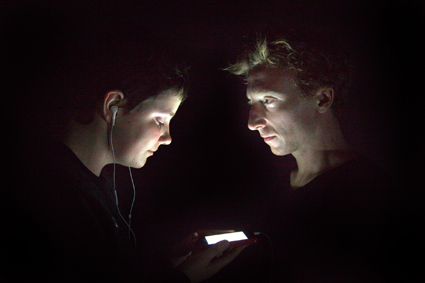deepening the festival experience
keith gallasch: emily sexton, artistic director, next wave 2012

Zoe Meagher, Goodbye CSIRAC
photo Matthew Kneale
Zoe Meagher, Goodbye CSIRAC
ARTISTIC DIRECTOR EMILY SEXTON SEES NEXT WAVE 2012 AS “A SOCIALLY AND POLITICALLY ENGAGED FESTIVAL. WE WANTED TO CREATE AN EXPERIENTIAL DYNAMIC IN THE WAY YOU SEE ART.”
To this end, the festival invites you to start each day with a couple of hours at the Breakfast Club at the Wheeler Centre for Writing, Books and Ideas over coffee and the provocations of visiting international curators. Then you can spend the rest of the day exploring a variety of shows, installations and events across the city. Create your own trajectory or take up the festival’s offer of a choice of nine different day passes, each with a guide and each from breakfast to late night. That means sharing the experience with a group of fellow audience members for a day: “That’s where the cut and thrust is to be had,” says Sexton, “in the dialogue you have before and after experiencing an artwork and we wanted to make that as easy as possible.” She makes the point that the festival presents multidisciplinary works but wants to create a multidisciplinary context—hence this sharing: “It’s about our own practice as a festival.”
Consequently, Next Wave 2012 has an emphasis on “people coming together around everyday experiences expanded into intense versions: breakfasts, a wedding, markets, walks—all exploded into a contemporary art context. Next Wave is not like mainstream arts festivals that make certain promises. It’s about people exploring things and taking risks, so you have to create an environment that is about risk as well. I thought a lot about great music festivals: you go for the headliner but it’s the unknowns that everyone talks about afterwards. So we wanted to give people the opportunity to be surprised.”
Sexton emphasises the role of collaboration underpinning Next Wave: “Artists have made their work in collaboration with an amazing diversity of people in and around the arts. Elizabeth Dunn, for example, has created a beautiful project called Flyway in collaboration with birders for the last two years. Driving the great Australasian migration flyway up the east coast of Australia from Melbourne to her home in Queensland, she stayed along the way at migratory hotspots where birders live who generously opened up to her. Dunn made the journey into a metaphor, layering it over Melbourne to create a migratory walking tour from Carlton to Dockland mirroring her own journey.” Video monitors showing birds and locations will be encountered on the walk, the sightings aided by small binoculars for each walker. The sonic element will be provided by Brisbane sound artist Lawrence English.
In No Show’s Shotgun Wedding, gay artists Mark Pritchard and Bridget Balodis, who have been attending weddings and talking with priests for their research, will create an apparently very realistic wedding experience. The audience are the guests, eating, dancing and engaging with all the activities that come with, says Sexton, “one of the strongest of social rituals, one where many people fall back on tradition.” She describes this theatre work as insightful and very funny.
Next Wave 2012 features artists from across the country: “We really see it as a national festival—how many strange hotels have I been sleeping in over the last 18 months while searching for the artists who are the bravest and most curious in their practice.” As for artists beyond Australia, Sexton in her first year as director is focusing on making connections. Consequently, “Next Wave has created a residency program for emerging international festival directors and curators—people who are starting up things in different ways in the UK, Beijing, Korea, Indonesia and New York. Some we know well, some of it’s a bit of blind date, but we’re looking forward to a deep conversation with long term results.”
As for Next Wave 2012’s political dimension, Sexton describes the last two years as “a very strange time, with more and more people taking to the streets, but not always being able to articulate why they want change. I think that’s where art comes in so strongly because it uses the unconscious to help articulate our feelings. And not didactically. It’s all about discussion.” She cites Dan Koops’ The Stream/The Boat/The Shore/The Bridge, in which you’ll find yourself on a boat negotiating the Yarra, games and adventures while “thinking about our use of resources from a problem solving perspective.” Sarah-Jane Norman’s work, Bone Library (at the Melbourne City Library), about the loss of hundreds of Aboriginal languages, in which she carves their names on animal bones, is described by Sexton as “very mournful about what is dying around us that we can and can’t see.”

Skye Gellmann, Blindscape
photo Dom Bonnice
Skye Gellmann, Blindscape
Sexton says that she and her team started thinking about Next Wave 2012 in terms of generosity and urgency. “Urgency prompts us to make political work, while generosity is more complex—artists giving away parts of themselves and their ideas, often without reward.” Next Wave, with its mix of free and modestly priced ticketed events and the space it offers young artists to meet and challenge an audience bespeaks the political power of generosity. Sexton pays tribute to another kind of largesse, the advice received “from Next Wave alumni like Martyn Coutts, Willow S Wieland and Lara Thoms,” who in their own work in previous Next Waves, says Sexton, so effectively articulated cross-art practice which is, she emphasises, now no longer seen in terms of a clash of forms but as innate to contemporary practice.
Reading the Next Wave media kit I was struck by the sheer inventiveness, on paper, of many of the works soon to be realised. They include, from over 40 works, Team Mess’ Bingo Unit, participatory filmmaking and a backlot tour; Robin Hungerford’s Shamanic Organic Contemporary Cuisine cooking show; Talon Salon, an intimate audio theatre show and nail treatment in one, presented in an actual nail salon; The Greater Asia Co-Prosperity Sphere, a mock embassy (see p15); Fresh Produce, works presented in the Queen Victoria Market; Skye Gellman’s Blindscape, physical theatre experienced through iPhone and other intimacies; Creo Nova’s “proximity controlled xylophones, megaphone whirlwinds, singing plants and deep-sea gurglers”; and Tiffany Singh’s Drums between the Bells, one thousand strands of bells hanging from an elm tree in Melbourne’s City Square.
Zoe Meagher’s Goodbye, CSIRAC, in the Melbourne Museum, is a sound and performance work about Australia’s first computer “and its forgotten female operators”; Kel Mocilnik and Alison Currie go In the Pursuit of Repetition (fame and squalour) in a dance, visual and performance work for the duration of the festival beneath Federation Square; in Physical Fractals dancer Natalie Abbott and collaborator Rebecca Jensen “will produce intense sound effects by hurling microphones into the space and generating feedback from squeaky amplifiers”; in Exchange, Justin Shoulder will perform with Dewey Dell (Italy), an offshoot of Societàs Raffaello Sanzio; in The Warmth of the Curve, Michelle Sakaris explores cross-cultural walking practices; in Wheyface by Daniel ‘Room 328’ Santangeli, three post-apocalyptic curators “erroneously piece together the history of humankind”; and in Wintering, dancer Aimee Smith draws on her experience of the Arctic Circle to ask what it means “to live in a changing and disintegrating world?” And that’s a mere handful of works from a packed program that promises intense engagement, risk and dialogue.
2012 Next Wave, Melbourne, May 19-27, nextwave.org.au
RealTime issue #108 April-May 2012 pg. 16






